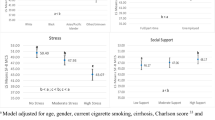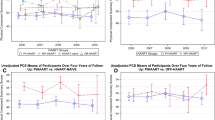Abstract
Hepatitis C virus (HCV) infection in prisoners represents an important public health problem. However, there is very little information about HCV-related health-related quality of life (HRQOL). We examined the effect of HCV antibody positivity, HCV viremia, and being a prisoner on prisoners'' HRQOL. Population-based health surveys incorporating HCV screening were conducted among prisoners at New South Wales (NSW), Australia, correctional centers in 1996 and 2001. HCV antibody and HCV RNA status were determined from venous blood sampling. HRQOL and mood status were assessed using the Short Form-36 (SF-36) Health Survey and Beck Depression Inventory (BDI). Comparison of HRQOL scores between HCV antibody negative, HCV antibody positive/non-viremic, and HCV antibody positive/viremic and assessment of temporal change in HRQOL between 1996 and 2001 within groups were made using ANCOVA adjusting for confounders. Factors associated with HRQOL were determined in linear regression models. Analyses between HCV antibody negative (n = 423), HCV positive/non-viremic (n = 89), and HCV positive/viremic (n = 178) prisoners found no measurable effect of HCV on HRQOL, including that attributable to HCV viremia. Compared to uninfected Australian population norms, prisoners had lower HRQOL irrespective of HCV status. The prevalence of ‘moderate’ to ‘severe’ depressive symptoms was greater in the HCV antibody positive/viremic group than the HCV antibody positive/non-viremic group or the HCV antibody negative group. Selected demographic factors (age), co-morbidity, severity of depressive symptoms and medical care utilization influenced HRQOL. There was evidence to support the effect of knowledge of HCV status on HRQOL. In conclusion, our findings contrast with previous studies in non-prisoner groups in which HCV infection appears to decrease overall HRQOL. Non-HCV factors may override HCV-specific HRQOL impairment in this population. Targeted management strategies are required to improve HRQOL of prisoners.

Similar content being viewed by others
References
Bonkovsky HL, Woolley JM. Reduction of health-related quality of life in chronic hepatitis C and improvement with interferon therapy. The Consensus Interferon Study Group. Hepatology. 1999;29:264–270.
Ware JE Jr, Bayliss MS, Mannocchia M, Davis GL. Health-related quality of life in chronic hepatitis C: impact of disease and treatment response. The Interventional Therapy Group. Hepatology. 1999;30:550–555.
Foster GR, Goldin RD, Thomas HC. Chronic hepatitis C virus infection causes a significant reduction in quality of life in the absence of cirrhosis. Hepatology. 1998;27:209–212.
Fontana RJ, Hussain KB, Schwartz SM, Moyer CA, Su GL, Lok AS. Emotional distress in chronic hepatitis C patients not receiving antiviral therapy. J Hepatol. 2002;36:401–407.
Fontana RJ, Moyer CA, Sonnad S, et al. Comorbidities and quality of life in patients with interferon-refractory chronic hepatitis C. Am J Gastroenterol. 2001;96:170–178.
Hussain KB, Fontana RJ, Moyer CA, Su GL, Sneed-Pee N, Lok AS. Comorbid illness is an important determinant of health-related quality of life in patients with chronic hepatitis C. Am J Gastroenterol. 2001;96:2737–2744.
Dalgard O, Egeland A, Skaug K, Vilimas K, Steen T. Health-related quality of life in active injecting drug users with and without chronic hepatitis C virus infection. Hepatology. 2004;39:74–80.
Rodger AJ, Jolley D, Thompson SC, Lanigan A, Crofts N. The impact of diagnosis of hepatitis C virus on quality of life. Hepatology. 1999;30:1299–1301.
McHutchison JG, Ware JE Jr, Bayliss MS, Pianko S, Albrecht JK, Cort S, Yang I, et al. The effects of interferon alpha-2b in combination with ribavirin on health related quality of life and work productivity. J Hepatol. 2001;34:140–147.
Butler T, Allnutt S, Cain D, Owens D, Muller C. Mental disorder in the New South Wales prisoner population. Aust N Z J Psychiatry. 2005;39:407–413.
Butler T, Milner L. The 2001 Inmate Health Survey. 2003. Sydney: NSW Corrections Health Service. ISBN: 0 7347 3560 X.
Butler T, Spencer J, Cui J, Vickery K, Zou J, Kaldor J. Seroprevalence of markers for hepatitis B, C and G in male and female prisoners—NSW, 1996. Aust N Z J Public Health. 1999;23:377–384.
Butler TG, Dolan KA, Ferson MJ, McGuinness LM, Brown PR, Robertson PW. Hepatitis B and C in New South Wales prisons: prevalence and risk factors. Med J Aust. 1997;166:127–130.
Charlson ME, Pompei P, Ales KL, MacKenzie RC. A new method of classifying prognostic comorbidity in longitudinal studies: development and validation. J Chronic Dis. 1987;40:373–383.
Darke S, Ward J, Zador D, Swift G. A scale for estimating the health status of opioid users. Br J Addict. 1991;86:1317–1322.
Ware JE Jr, Sherbourne CD. The MOS 36-item short-form health survey (SF-36): I. Conceptual framework and item selection. Med Care. 1992;30:473–483.
Likert R. A technique for the measurement of attitudes. Arch Psych. 1932;140:5–55.
Ware JE, Konsinski M. SF-36 ® Physical & Mental Health Summary Scales: a Manual for Users of Version 1. 2nd ed. Lincoln, Rhode Island: Quality Metric Incorporated; 2001.
Beck AT, Rush AJ, Shaw BF, Emery G. Cognitive Therapy of Depression. New York, New York: Guildford; 1979.
Butler T, Kariminia A, Levy M, Kaldor J. Prisons are a risk for hepatitis C transmission. Eur J Epidemiol. 2004;19:1119–1122.
Cronbach LJ, Warrington WG. Time-limit tests: estimating their reliability and degree of speeding. Psychometrika. 1951;16:167–188.
Altman DG. Practical Statistics for Medical Research. 1st ed. London: Chapman and Hall; 1991.
Australian Bureau of Statistics (ABS). National Health Survey: SF-36 population norms. Canberra: Australian Government Publishing Service; 1997.
Howell DC. Statistical Methods for Psychology. 5th ed. California: Thomson Learning; 2002.
Cohen J. Statistical Power Analysis for the Behavioral Sciences. 2nd ed. New York: Academic; 1988.
Nunnally JC. Psychometric Theory. New York: McGraw-Hill; 1978.
Ware JE Jr, Snow KK, Kosinski M, Gandek B. SF-36 Health Survey: Manual and Interpretation Guide. Boston, Massachusetts: The Health Institute, New England Medical Center; 1993.
Matthews G, Kronborg IJ, Dore GJ. Treatment for hepatitis C virus infection among current injection drug users in Australia. Clin Infect Dis. 2005;40(Suppl 5):S325–S329.
Spiegel BM, Younossi ZM, Hays RD, Revicki D, Robbins S, Kanwal F. Impact of hepatitis C on health related quality of life: a systematic review and quantitative assessment. Hepatology. 2005;41:790–800.
Forton DM, Thomas HC, Murphy CA, Allsop JM, Foster GR, Main J, Wesnes KA, et al. Hepatitis C and cognitive impairment in a cohort of patients with mild liver disease. Hepatology. 2002;35:433–439.
Forton DM, Allsop JM, Main J, Foster GR, Thomas HC, Taylor-Robinson SD. Evidence for a cerebral effect of the hepatitis C virus. Lancet. 2001;358:38–39.
Fiala M, Looney DJ, Stins M, et al. TNF-alpha opens a paracellular route for HIV-1 invasion across the blood–brain barrier. Mol Med. 1997;3:553–564.
Forton D, Taylor-Robinson S, Karayiamnis P, Thomas H. Identification of brain-specific quasispecies variants of hepatitis C virus (HCV) consistent with viral replication in the central nervous system. Hepatology. 2000;32(Suppl):269A.
Thomas HC, Torok ME, Forton DM, Taylor-Robinson SD. Possible mechanisms of action and reasons for failure of antiviral therapy in chronic hepatitis C. J Hepatol. 1999;31(Suppl 1):152–159.
Gijsen R, Hoeymans N, Schellevis FG, Ruwaard D, Satariano WA, van den Bos GA. Causes and consequences of comorbidity: a review. J Clin Epidemiol. 2001;54:661–674.
Schwarzinger M, Dewedar S, Rekacewicz C, et al. Chronic hepatitis C virus infection: does it really impact health-related quality of life? A study in rural Egypt. Hepatology. 2004;40:1434–1441.
Cordoba J, Reyes J, Esteban JI, Hernandez JM. Labeling may be an important cause of reduced quality of life in chronic hepatitis C. Am J Gastroenterol. 2003;98:226–227.
Michelson H, Bolund C, Brandberg Y. Multiple chronic health problems are negatively associated with health related quality of life (HRQoL) irrespective of age. Qual Life Res. 2000;9:1093–1104.
Mooney M, Hannon F, Barry M, Friel S, Kelleher C. Perceived quality of life and mental health status of Irish female prisoners. Ir Med J. 2002;95:241–243.
Acknowledgement
The authors acknowledge the reviewers for helpful comments on an earlier draft of the manuscript.
The National Centre in HIV Epidemiology and Clinical Research is funded by the Australian Government Department of Health and Ageing and is affiliated with the Faculty of Medicine, The University of New South Wales. Justice Health (NSW) provided the data used in the analysis.
Author information
Authors and Affiliations
Corresponding author
Additional information
Thein, Kaldor, and Dore are with the National Centre in HIV Epidemiology and Clinical Research, The University of New South Wales, Sydney, NSW, Australia; Butler and Levy are with the Centre for Health Research in Criminal Justice, Sydney, NSW, Australia; Butler is with the School of Public Health and Community Medicine, The University of New South Wales, Sydney, NSW, Australia; Krahn is with the Departments of Medicine and Health Policy, Management and Evaluation, University of Toronto, Ontario, Canada; Rawlinson is with the Virology Division SEALS Prince of Wales Hospital, The University of New South Wales, Sydney, NSW, Australia.
Presented in part: 2nd Prisoners Health Research Symposium, February 2005, Sydney, New South Wales, Australia. 4th Australian Hepatitis C Conference, August 2004, Canberra, Australia.
Rights and permissions
About this article
Cite this article
Thein, HH., Butler, T., Krahn, M. et al. The Effect of Hepatitis C Virus Infection on Health-Related Quality of Life in Prisoners. JURH 83, 275–288 (2006). https://doi.org/10.1007/s11524-005-9015-4
Published:
Issue Date:
DOI: https://doi.org/10.1007/s11524-005-9015-4




